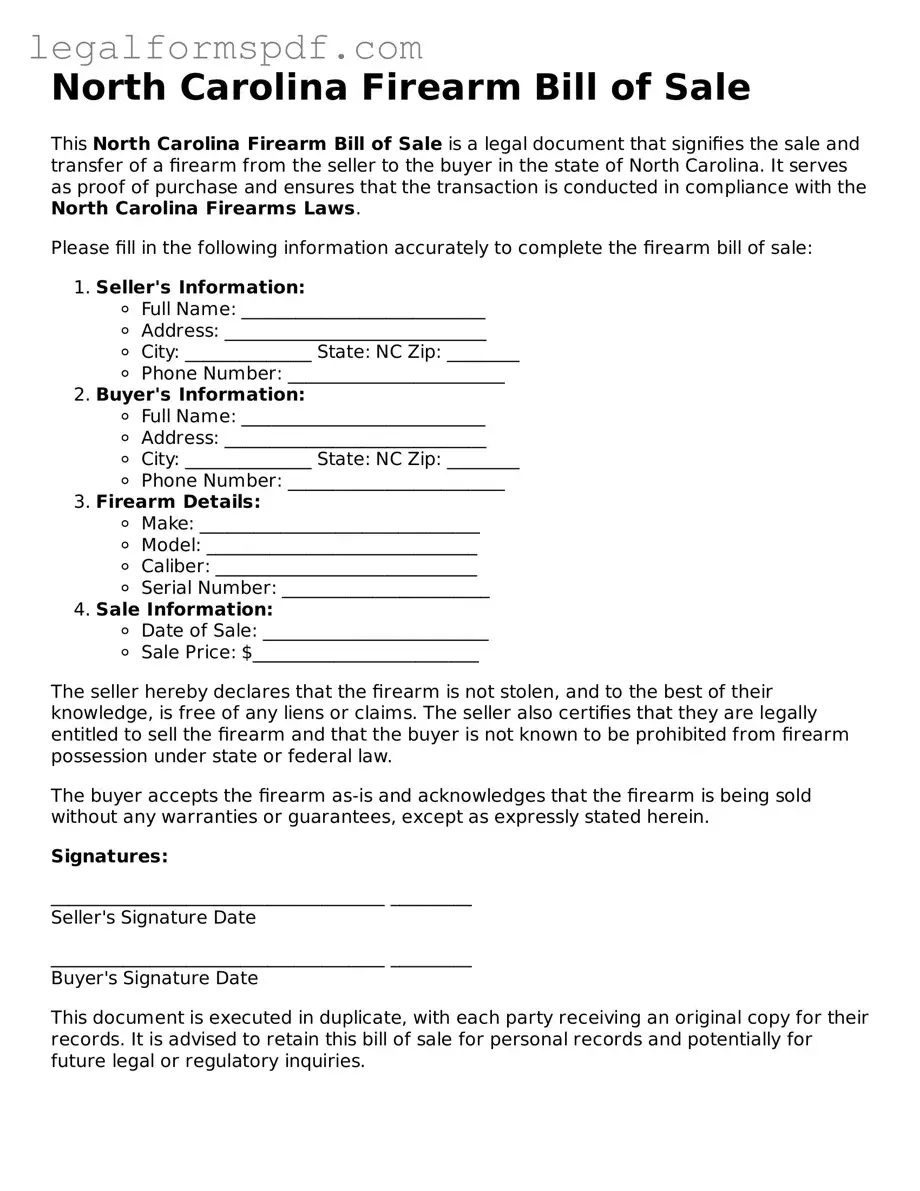The North Carolina Firearm Bill of Sale form shares similarities with the General Bill of Sale. Both documents serve the purpose of recording a transfer of ownership between a seller and a buyer. Like the Firearm Bill of Sale, the General Bill of Sale provides basic information such as the details of the transaction, the parties involved, and the date of sale. However, the General Bill of Sale is more versatile and can be used for a wide variety of items, not just firearms.
Comparable to the North Carolina Firearm Bill of Sale form is the Vehicle Bill of Sale. This form is specifically used when buying or selling a vehicle. It captures essential information like the make, model, and VIN (Vehicle Identification Number) of the vehicle, paralleling the firearm form's requirement for specific identification details (such as make, model, and serial number of the firearm). Both forms legally document the transfer of ownership and are crucial for the registration process in their respective contexts.
The Boat Bill of Sale is another document with a similar purpose to the North Carolina Firearm Bill of Sale form. It is used when transferring ownership of a boat. Both forms include specifics about the item being sold (such as the boat's length, make, and hull ID or the firearm's make, model, and serial number), the sale price, and the parties involved in the transaction. These details ensure that the ownership transfer is well-documented and legally binding.
Similar in function to the North Carolina Firearm Bill of Sale form, the Equine Bill of Sale documents the sale or transfer of a horse. Both forms require detailed descriptions of the item being sold, including identifying features (such as breed, color, and age for the horse, or make, model, and serial number for the firearm), thereby providing a clear record of what is being transferred.
The Business Bill of Sale is akin to the North Carolina Firearm Bill of Sale form in its role in documenting the sale of assets. While the Firearm Bill of Sale focuses on a specific item, the Business Bill of Sale typically covers a wider array of assets being transferred with a business sale. Despite this, both documents formalize the transfer process and include details about the seller, buyer, and the terms of the sale.
Likewise, the North Carolina Firearm Bill of Sale form parallels the Artwork Bill of Sale. Both are designed to record the sale of specific items, detailing the object's unique characteristics (such as artist and medium for artwork, or make and model for firearms). This specificity ensures that both the buyer and seller acknowledge the exact item being transferred, providing legal protection and clarity.
The Pet Bill of Sale shares its core purpose with the North Carolina Firearm Bill of Sale form: to document the transfer of ownership. In the case of the Pet Bill of Sale, it concerns the sale of animals, detailing the pet's breed, age, and health information. This is analogous to the firearm form’s detailing of an item's specific identifiers, underlining the importance of transparently recording such transfers.
Lastly, the North Carolina Firearm Bill of Sale form mirrors the Equipment Bill of Sale in its aim to record the transfer of ownership of physical assets. The Equipment Bill of Sale is used for items like machinery or office equipment, requiring details similar to those in the firearm sale form, such as the item's description, condition, and serial number. Both forms serve to legally document the agreement between buyer and seller, ensuring a clear understanding of the transaction details.
